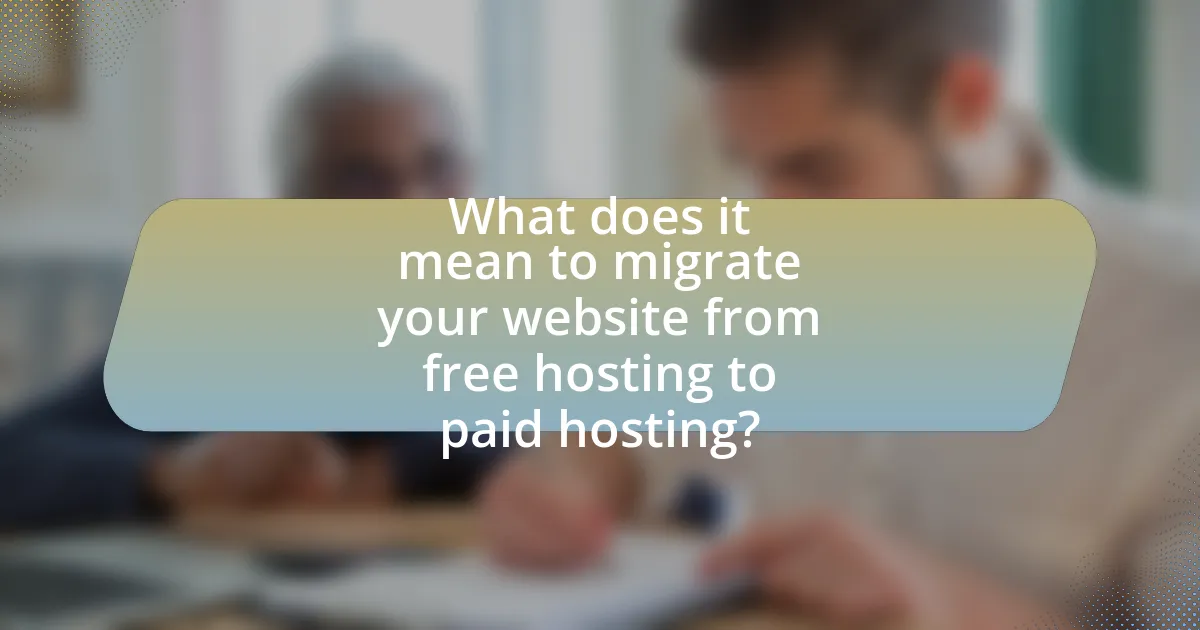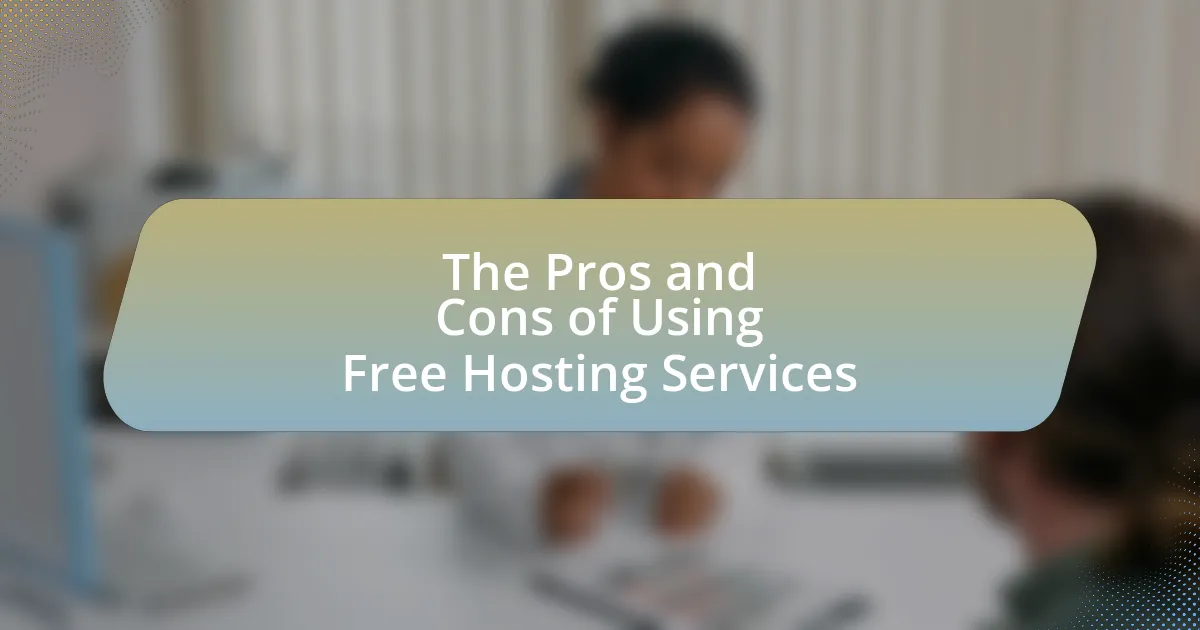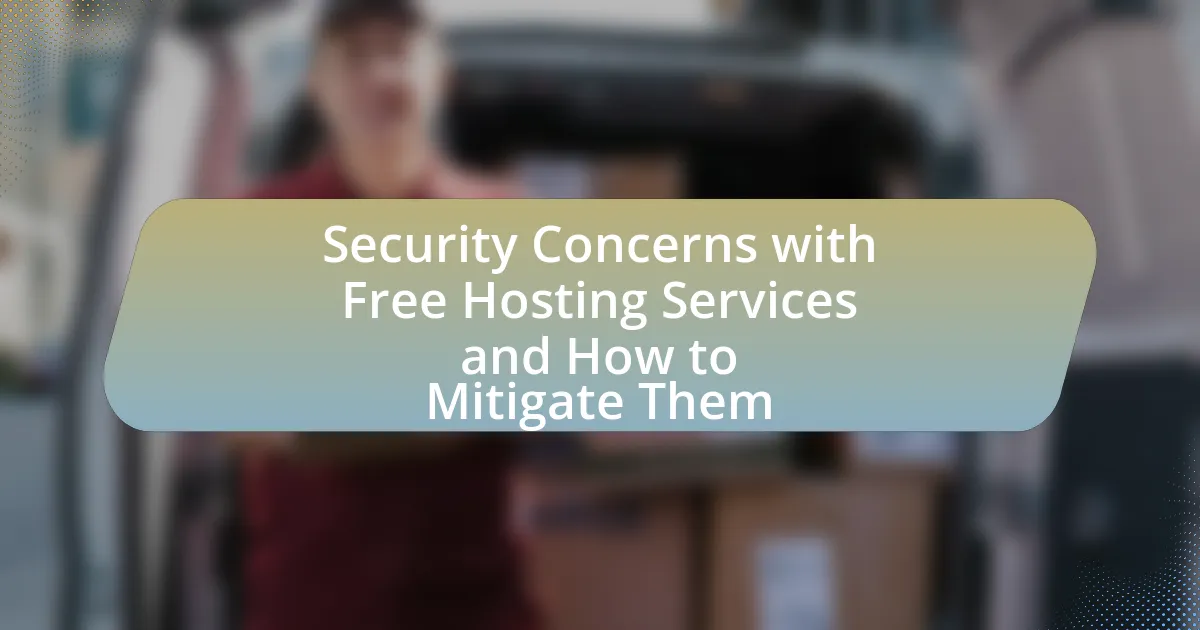Migrating your website from free hosting to paid hosting involves transferring files, databases, and configurations to a more robust hosting provider. This process addresses the limitations of free hosting, such as poor performance, restricted bandwidth, and lack of support, which can negatively impact user experience and SEO. Key steps in the migration include backing up data, selecting a suitable paid hosting plan, transferring files, updating DNS settings, and testing the website post-migration. The article also outlines best practices for ensuring a smooth transition and ongoing maintenance considerations to enhance website performance and security.

What does it mean to migrate your website from free hosting to paid hosting?
Migrating your website from free hosting to paid hosting means transferring your website’s files, databases, and configurations from a free hosting service to a paid hosting provider. This process typically involves selecting a paid hosting plan, backing up your website data, uploading it to the new server, and updating your domain’s DNS settings to point to the new hosting provider. Paid hosting often offers enhanced features such as better performance, increased storage, improved security, and customer support, which are not typically available with free hosting services.
Why should you consider migrating from free hosting?
Migrating from free hosting is advisable due to limitations in performance, reliability, and support. Free hosting often results in slower website speeds, which can negatively impact user experience and SEO rankings. Additionally, free hosting services typically impose restrictions on bandwidth and storage, leading to potential downtime during traffic spikes. According to a study by Google, a one-second delay in page load time can lead to a 20% decrease in conversions. Furthermore, free hosting usually lacks professional customer support, making it difficult to resolve issues promptly. Upgrading to paid hosting provides enhanced resources, better security, and dedicated support, ensuring a more stable and efficient online presence.
What are the limitations of free hosting services?
Free hosting services have several limitations, including restricted storage space, limited bandwidth, and lack of customer support. These constraints can hinder website performance and scalability, as many free hosting providers impose strict quotas that can lead to slow loading times or downtime during high traffic periods. Additionally, free hosting often includes mandatory advertisements, which can detract from the user experience and brand image. Security features are typically minimal, leaving websites vulnerable to attacks. Furthermore, users may not have access to their own domain name, which can affect credibility and search engine optimization.
How can paid hosting improve your website’s performance?
Paid hosting can significantly improve your website’s performance by providing dedicated resources, faster loading times, and enhanced security features. Unlike free hosting, which often shares server resources among multiple users, paid hosting allocates specific bandwidth and storage to your site, resulting in quicker response times and reduced downtime. For instance, a study by Google found that a one-second delay in loading time can lead to a 20% decrease in conversions, highlighting the importance of speed. Additionally, paid hosting typically includes advanced security measures, such as SSL certificates and regular backups, which protect your site from cyber threats and data loss, further enhancing overall performance.
What are the key steps involved in the migration process?
The key steps involved in the migration process from free hosting to paid hosting include planning, backing up data, choosing a new hosting provider, transferring files, updating DNS settings, and testing the website.
Planning involves assessing the current website and determining the requirements for the new hosting environment. Backing up data ensures that all website files, databases, and configurations are securely saved before migration. Choosing a new hosting provider requires evaluating options based on performance, support, and pricing. Transferring files involves moving website content to the new server, often using FTP or a migration tool. Updating DNS settings is necessary to point the domain to the new hosting provider, which may take time to propagate. Finally, testing the website on the new host ensures that all functionalities work correctly before fully switching over.
How do you choose the right paid hosting provider?
To choose the right paid hosting provider, evaluate key factors such as reliability, performance, customer support, and pricing. Reliability is crucial; look for providers with at least 99.9% uptime guarantees, as downtime can significantly impact your website’s accessibility. Performance metrics, including server speed and load times, should also be assessed; faster servers enhance user experience and SEO rankings. Customer support is vital; opt for providers offering 24/7 support through multiple channels, ensuring assistance is available when needed. Finally, compare pricing plans, ensuring they align with your budget while providing necessary features like bandwidth, storage, and security. Research shows that 70% of users abandon a website that takes more than three seconds to load, highlighting the importance of performance in your choice.
What preparations are necessary before migration?
Before migration, it is essential to back up all website data, including files and databases. This ensures that no information is lost during the transition. Additionally, reviewing the current website’s structure and functionality helps identify any necessary changes or improvements that should be made in the new hosting environment. It is also important to choose a suitable paid hosting plan that meets the website’s needs, considering factors such as bandwidth, storage, and support. Finally, updating domain settings and preparing for DNS changes are crucial steps to ensure a smooth transition to the new hosting provider.

How do you prepare for the migration from free to paid hosting?
To prepare for the migration from free to paid hosting, first, select a suitable paid hosting provider that meets your website’s needs. This involves evaluating factors such as server performance, customer support, scalability, and pricing plans. Next, back up all website files and databases from the free hosting platform to ensure no data is lost during the transition. Additionally, review and update your domain settings to point to the new hosting provider, which may include changing DNS records. Finally, test the website on the new hosting environment before fully switching over to confirm that everything functions correctly. This preparation ensures a smooth migration process and minimizes downtime.
What data and files need to be backed up?
To successfully migrate a website from free hosting to paid hosting, it is essential to back up website files, databases, and configuration settings. Website files include HTML, CSS, JavaScript, images, and any other media that make up the site’s content. Databases, such as MySQL or PostgreSQL, store dynamic content and user data, which must be exported for a complete backup. Configuration settings, including server settings and application configurations, are crucial for ensuring the website functions correctly on the new hosting environment. Backing up these components ensures a smooth transition and minimizes the risk of data loss during the migration process.
How can you effectively back up your website data?
To effectively back up your website data, utilize a combination of automated backup solutions and manual exports. Automated backup solutions, such as plugins for content management systems like WordPress, can schedule regular backups, ensuring that your data is consistently saved without manual intervention. For instance, plugins like UpdraftPlus or BackupBuddy can create backups of your entire site, including databases and files, and store them in cloud services like Google Drive or Dropbox.
Additionally, performing manual exports of your website’s database and files provides an extra layer of security. For example, using phpMyAdmin, you can export your database as an SQL file, while FTP clients like FileZilla allow you to download all website files to your local machine. This dual approach of automated and manual backups ensures comprehensive data protection, minimizing the risk of data loss during the migration process from free hosting to paid hosting.
What tools can assist in backing up your website?
Tools that can assist in backing up your website include plugins like UpdraftPlus, BackupBuddy, and Duplicator for WordPress, as well as services like CodeGuard and SiteGround’s backup solutions. UpdraftPlus allows users to schedule automatic backups and store them in various cloud services, while BackupBuddy offers complete site backups and easy restoration options. Duplicator enables users to create a package of their site for migration or backup purposes. CodeGuard provides continuous monitoring and automated backups, ensuring that changes are captured in real-time. SiteGround’s backup solutions offer daily backups and one-click restore features, enhancing data security. These tools are widely recognized for their reliability and effectiveness in safeguarding website data.
How do you select the best paid hosting plan for your needs?
To select the best paid hosting plan for your needs, evaluate your website’s requirements, including traffic volume, storage space, and technical support. Assess the hosting types available, such as shared, VPS, or dedicated hosting, based on your expected growth and performance needs. For instance, if your website anticipates high traffic, a VPS or dedicated plan may be more suitable due to their enhanced resources and performance capabilities. Additionally, consider the hosting provider’s uptime guarantees, customer reviews, and scalability options to ensure long-term satisfaction. Research shows that 99.9% uptime is a standard benchmark for reliable hosting services, which can significantly impact your website’s accessibility and user experience.
What factors should you consider when evaluating hosting plans?
When evaluating hosting plans, consider factors such as performance, scalability, security, customer support, and pricing. Performance is crucial as it affects website speed and uptime; for instance, a hosting provider with a 99.9% uptime guarantee ensures reliability. Scalability allows your website to grow without issues, which is essential for handling increased traffic. Security features, including SSL certificates and regular backups, protect your data and enhance user trust. Customer support should be responsive and available 24/7, as timely assistance can resolve issues quickly. Lastly, pricing should align with your budget while providing the necessary features; for example, a plan that offers a good balance of resources at a competitive price can be more cost-effective in the long run.
How do different hosting types (shared, VPS, dedicated) compare?
Shared hosting is the most economical option, where multiple websites share a single server’s resources, making it suitable for small websites with low traffic. VPS (Virtual Private Server) hosting offers a middle ground, providing dedicated resources within a shared environment, which enhances performance and control for medium-sized websites. Dedicated hosting, on the other hand, allocates an entire server to a single website, offering maximum performance, security, and customization, ideal for large websites with high traffic demands. According to a 2022 survey by HostingAdvice, 70% of users on shared hosting reported limitations in performance, while 85% of dedicated hosting users noted improved site speed and reliability.

What are the technical steps to migrate your website?
To migrate your website from free hosting to paid hosting, follow these technical steps: First, back up your website files and database from the free hosting provider. This can be done using FTP (File Transfer Protocol) to download files and a database management tool like phpMyAdmin to export the database. Next, purchase a hosting plan from a paid provider and set up your domain name. After that, upload your website files to the new hosting server using FTP and import your database using the database management tool provided by the new host. Finally, update your domain’s DNS settings to point to the new hosting server, ensuring that the changes propagate correctly. These steps are essential for a successful migration, as they ensure that all website data is transferred and accessible on the new hosting platform.
How do you transfer your website files to the new host?
To transfer your website files to the new host, use an FTP client to connect to both your old and new hosting accounts. First, download all website files from the old host to your local computer. Then, upload these files from your local computer to the new host using the FTP client. This method ensures that all files, including HTML, CSS, images, and scripts, are accurately transferred. FTP clients like FileZilla or Cyberduck are commonly used for this purpose, providing a straightforward interface for file management.
What methods can you use to upload files to the new server?
You can upload files to the new server using methods such as FTP (File Transfer Protocol), SFTP (Secure File Transfer Protocol), and web-based file managers. FTP allows for efficient transfer of large files and is widely supported by hosting providers, while SFTP provides an added layer of security by encrypting the data during transfer. Web-based file managers, often included in hosting control panels, enable users to upload files directly through a browser interface, simplifying the process for those less familiar with command-line tools. These methods are commonly utilized in website migration processes, ensuring that files are transferred securely and effectively.
How do you ensure that all files are transferred correctly?
To ensure that all files are transferred correctly during a website migration from free hosting to paid hosting, utilize a reliable file transfer protocol (FTP) client to manage the transfer process. This method allows for the verification of file integrity through checksums or hashes, ensuring that each file is accurately copied without corruption. Additionally, performing a comparison of file sizes and modification dates before and after the transfer can further confirm that all files have been successfully migrated. Using these techniques minimizes the risk of data loss and ensures a smooth transition to the new hosting environment.
How do you update your domain settings after migration?
To update your domain settings after migration, access your domain registrar’s control panel and modify the DNS records to point to the new hosting provider’s nameservers. This process typically involves replacing the existing nameservers with those provided by the new hosting service, ensuring that your domain resolves correctly to the new server. According to ICANN guidelines, DNS changes can take up to 48 hours to propagate fully across the internet, which is a standard timeframe for such updates.
What changes need to be made to your DNS settings?
To migrate your website from free hosting to paid hosting, you need to update your DNS settings by changing the nameservers to those provided by your new hosting provider. This change directs traffic from your domain to the new server, ensuring that visitors reach your website hosted on the paid plan. Typically, your new hosting provider will supply specific nameserver addresses, which you must enter in your domain registrar’s DNS management panel. This process is essential for a successful migration, as it links your domain to the new hosting environment, allowing for proper functionality and accessibility of your website.
How long does it take for DNS changes to propagate?
DNS changes typically take between a few minutes to 48 hours to propagate fully. This variation is due to factors such as the Time to Live (TTL) settings configured on the DNS records, which dictate how long a DNS record is cached by servers and clients. For instance, if the TTL is set to one hour, changes may be reflected within that timeframe, while longer TTLs can delay propagation. Additionally, different ISPs may update their DNS caches at varying intervals, contributing to the overall propagation time.
What common issues might arise during the migration process?
Common issues that might arise during the migration process include data loss, downtime, and compatibility problems. Data loss can occur if files are not transferred correctly or if backups are not made prior to migration. Downtime may happen due to DNS propagation delays or server configuration errors, leading to a temporary unavailability of the website. Compatibility problems can arise if the new hosting environment does not support certain technologies or configurations used in the original setup, potentially causing functionality issues. These challenges are well-documented in migration case studies, highlighting the importance of thorough planning and testing to mitigate risks.
How can you troubleshoot website downtime after migration?
To troubleshoot website downtime after migration, first check the DNS settings to ensure they point to the new server. Incorrect DNS configurations can lead to downtime, as they may still direct traffic to the old hosting provider. Additionally, verify that the new server is properly configured, including checking server logs for errors and ensuring that all necessary files and databases have been transferred correctly. According to a study by the Internet Society, 75% of website downtime issues stem from DNS misconfigurations or server mismanagement, highlighting the importance of these checks in resolving downtime effectively.
What steps can you take if your website doesn’t function properly post-migration?
If your website doesn’t function properly post-migration, first check the DNS settings to ensure they point to the new hosting server. Incorrect DNS settings can lead to website accessibility issues. Next, verify that all files and databases were transferred correctly; missing files or incomplete database migrations can cause functionality problems. Additionally, review the website’s configuration files, such as .htaccess or wp-config.php, for any errors or misconfigurations that may have occurred during the migration process. Finally, clear your browser cache and any server-side cache to ensure you are viewing the most recent version of your site. These steps are essential for diagnosing and resolving common post-migration issues effectively.
What best practices should you follow during and after migration?
During and after migration, it is essential to perform a comprehensive backup of your website data to prevent data loss. This includes files, databases, and configurations, ensuring that you can restore your site if any issues arise during the migration process. Additionally, you should update your DNS settings promptly to reflect the new hosting provider, which typically involves changing the nameservers to point to the new server.
Monitoring the website’s performance post-migration is crucial; this can be done using tools like Google Analytics and server logs to identify any issues that may affect user experience. Furthermore, testing all functionalities, including forms, links, and payment gateways, ensures that everything operates smoothly after the transition.
Finally, informing users about the migration can enhance transparency and trust, especially if there are expected downtimes or changes in service. Following these best practices minimizes risks and ensures a seamless transition from free to paid hosting.
How can you ensure a smooth transition to paid hosting?
To ensure a smooth transition to paid hosting, first, back up all website data, including files and databases, to prevent data loss during the migration. This step is crucial as it allows for recovery in case of any issues during the transition. Next, choose a reliable paid hosting provider that meets your website’s needs, considering factors such as uptime, customer support, and scalability. After selecting a provider, update your domain’s DNS settings to point to the new hosting server, which typically takes 24 to 48 hours to propagate. Finally, test your website thoroughly on the new hosting environment to ensure all functionalities work correctly before fully switching over. This methodical approach minimizes downtime and ensures a seamless transition.
What ongoing maintenance should you consider after migration?
After migration, ongoing maintenance should include regular backups, security updates, performance monitoring, and content management. Regular backups ensure that data can be restored in case of loss, while security updates protect against vulnerabilities that could be exploited by attackers. Performance monitoring helps identify issues that may affect user experience, such as slow loading times, and content management ensures that the website remains relevant and engaging for users. According to a study by the Ponemon Institute, 60% of small businesses that experience a data breach go out of business within six months, highlighting the importance of these maintenance practices.





